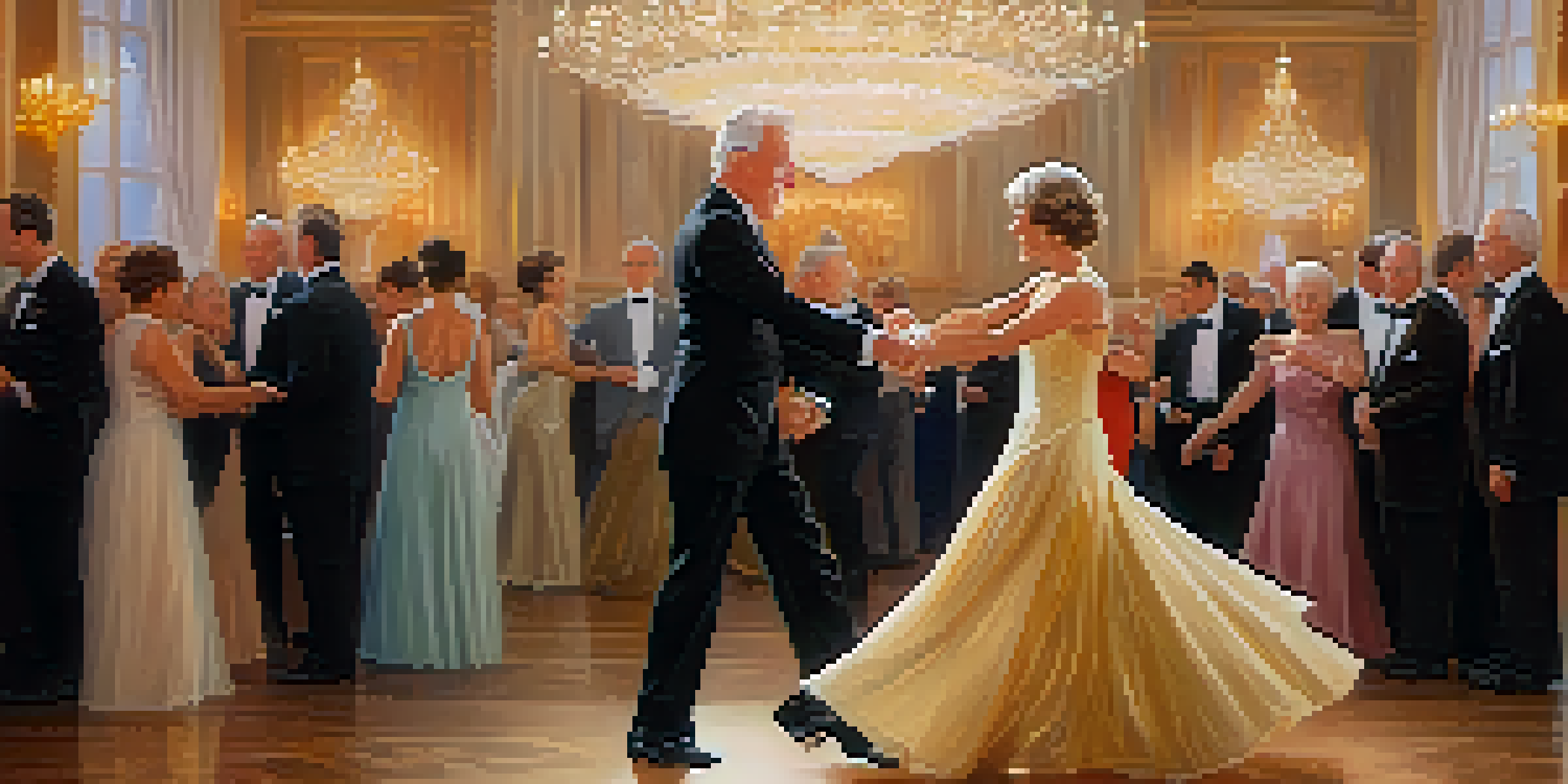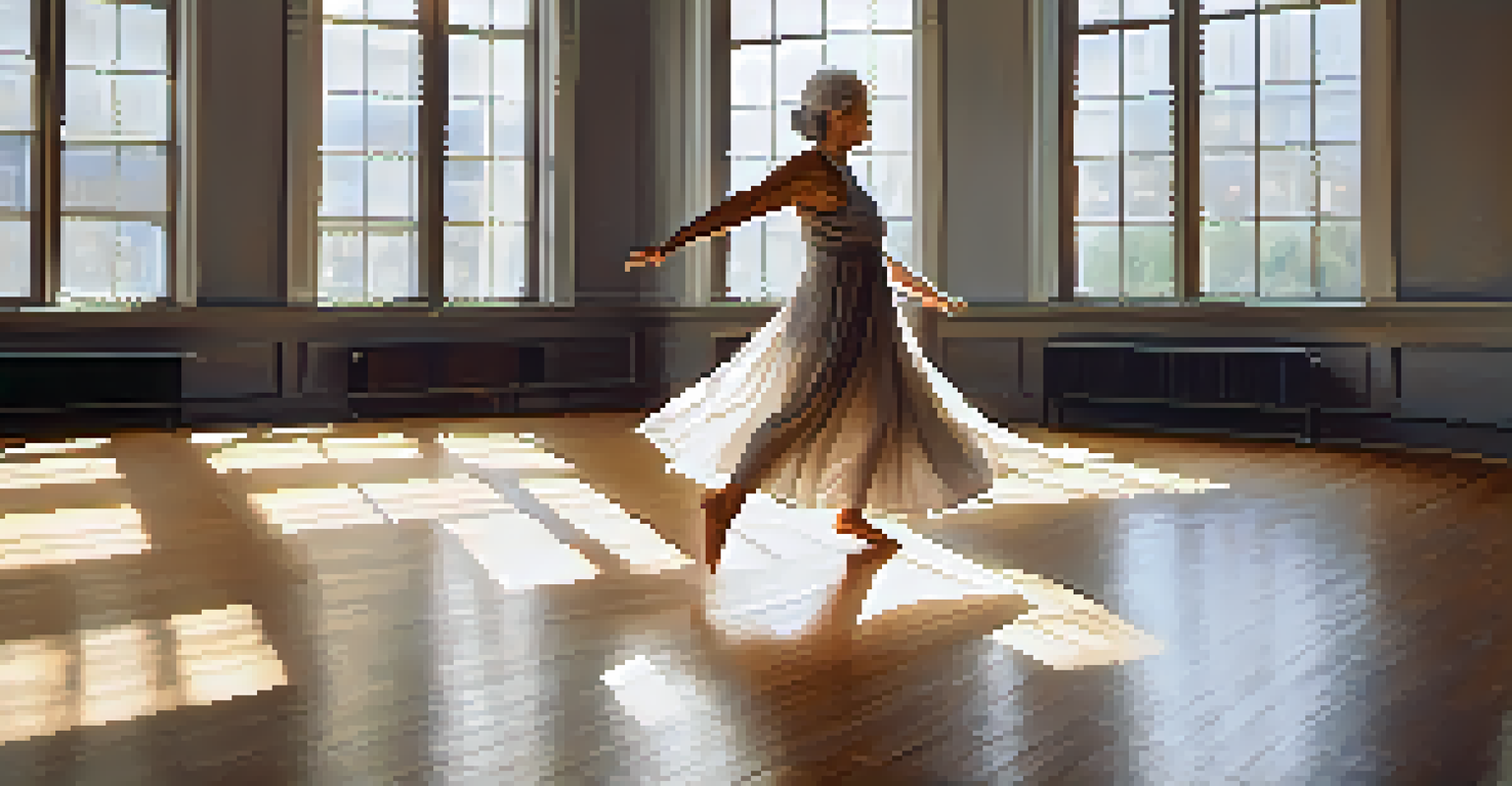Dance Styles that Promote Creativity Among Older Adults

The Joy of Movement: Why Dance Matters for Older Adults
Dance is more than just a form of exercise; it’s a celebration of movement and self-expression. For older adults, engaging in dance can ignite a sense of joy and creativity that might have been dormant. As they sway to the rhythm, they not only connect with music but also rediscover their own bodies and capabilities.
Dance is the hidden language of the soul.
Participating in dance classes or social dance gatherings provides opportunities for social interaction, which is crucial for mental health. In a welcoming environment, older adults can forge new friendships, share experiences, and create memories, all while moving to the beat. This social aspect enhances the creative experience, making dancing a holistic activity.
Moreover, the improvisational nature of many dance styles encourages individuals to think outside the box. This freedom to explore movement helps stimulate cognitive function and fosters a playful mindset, reminding us that creativity knows no age limits.
Exploring Ballet: Grace and Creativity Combined
Ballet might seem like a rigid art form, but it offers older adults a unique opportunity to express creativity through structured movement. The focus on posture, balance, and grace allows participants to embody a sense of elegance, which can be incredibly empowering. It’s about mastering technique while also allowing individual interpretation.

Many community centers offer ballet classes tailored for seniors, ensuring that the pace and intensity are appropriate. This nurturing environment encourages participants to connect with their creativity while learning a beautiful art form. The feeling of accomplishment from mastering a challenging move can boost self-esteem and inspire further exploration.
Dance Boosts Joy and Creativity
Engaging in dance helps older adults rediscover joy and creativity while connecting with their bodies and music.
Additionally, ballet often incorporates storytelling, inviting dancers to convey emotions through their movements. This aspect not only engages their imagination but also fosters a deeper connection to the music, making each class a journey of creative discovery.
Salsa: A Dance Filled with Passion and Expression
Salsa dancing is vibrant and energetic, making it an excellent choice for older adults looking to unleash their spontaneity. The lively music and rhythmic footwork create an inviting atmosphere where creativity can flourish. Dancing salsa isn’t just about the steps; it’s also about the connection with partners and the energy of the crowd.
To watch us dance is to hear our hearts speak.
In salsa classes, improvisation plays a significant role, allowing dancers to express their personality through movement. This freedom can be liberating for older adults, reminding them that creativity is not confined to any specific form or style. The joy of dancing with a partner also enhances the experience, as it encourages communication and connection.
Moreover, salsa is known for its cultural roots, providing a rich backdrop for participants to explore. Engaging with the history and traditions of salsa can inspire creativity, as dancers discover how to incorporate their own stories and backgrounds into their movements.
Line Dancing: Structured Fun and Creativity Unleashed
Line dancing, often associated with country music, offers a fun and structured way for older adults to express themselves. The repetitive patterns and easy-to-follow steps allow participants to focus on creativity without the pressure of partner dancing. This independence can be particularly appealing for those who prefer to dance at their own pace.
As they learn new routines, older adults can infuse their personal flair into each movement, making the dance their own. The social aspect of line dancing—often performed in groups—fosters a sense of community, encouraging participants to share experiences and enjoy each other's company. This camaraderie can spark creativity through shared ideas and inspiration.
Social Interaction Enhances Wellness
Participating in dance fosters social connections, which are vital for mental health and overall well-being among older adults.
Additionally, the upbeat nature of line dancing can uplift moods and boost energy levels. The blend of exercise and social interaction creates a perfect environment for creativity to thrive, proving that dancing can be both fun and fulfilling at any age.
Tap Dance: Rhythm and Imagination in Every Step
Tap dance is a dynamic and rhythmic form of dance that invites creativity through sound. Each tap of the shoe creates music, allowing older adults to express themselves in a unique way. The emphasis on rhythm encourages participants to think creatively about how they move, making each class a joyful exploration of sound and movement.
Older adults can find tap classes that cater to various skill levels, ensuring that everyone can join in the fun. The sense of accomplishment from creating intricate rhythms can be incredibly satisfying. Moreover, the opportunity to improvise and experiment with sounds fosters a playful and imaginative atmosphere.
As they engage with the music and their own creativity, tap dancers often find themselves connecting with their inner child. This liberating experience not only enhances their dance skills but also promotes emotional well-being, reinforcing the idea that creativity is a lifelong journey.
Modern Dance: Freedom of Expression and Movement
Modern dance emphasizes creativity and individual expression, making it an ideal choice for older adults seeking to explore their artistic side. Unlike more traditional dance forms, modern dance encourages dancers to interpret music and movement in their own way. This freedom can be incredibly empowering, allowing participants to express their emotions and stories.
Classes often focus on improvisation and personal exploration, which can lead to surprising and delightful discoveries. Older adults are encouraged to tap into their feelings and experiences, transforming them into movement. This process not only promotes creativity but also fosters self-discovery and emotional healing.
Dance Offers Holistic Health Benefits
Beyond creativity, dance improves physical health, cognitive function, and emotional well-being, enriching the lives of older adults.
By engaging in modern dance, older adults can also enhance their physical fitness and flexibility. The focus on body awareness creates a deeper connection between mind and body, reinforcing the idea that creativity and health go hand in hand as they navigate this rewarding artistic journey.
Ballroom Dance: Elegance Meets Creative Expression
Ballroom dancing is a beautiful blend of grace, technique, and creativity. Whether it's the waltz, tango, or foxtrot, older adults can find joy in learning these classic dances while expressing their unique personalities. The structured nature of ballroom allows for creativity within a framework, making it accessible and rewarding.
In ballroom classes, older adults often pair up, fostering connections and encouraging communication through movement. This social aspect can enhance their overall experience, allowing dancers to share ideas and inspire each other creatively. The beauty of partner dancing lies in the ability to create a harmonious flow between two individuals.

Moreover, ballroom dance often features music that resonates with personal memories, adding layers of emotional depth to the experience. By connecting music, movement, and shared stories, older adults can create a rich tapestry of creativity that celebrates their life journey.
The Benefits of Dance Beyond Creativity
While the focus of this article is on creativity, it’s essential to acknowledge the numerous benefits dance brings to older adults. Regular dancing improves physical health by enhancing balance, coordination, and cardiovascular fitness, all of which are vital for maintaining independence. The combination of movement and music can also boost mood and reduce feelings of anxiety or depression.
Additionally, dancing stimulates cognitive function, keeping the mind sharp and engaged. The challenge of learning new steps or routines enhances memory and focus, making dance not just a form of expression but also a mental workout. This holistic approach to well-being is particularly valuable for older adults.
Ultimately, the act of dancing fosters a deeper connection to oneself and the world around. As older adults embrace various dance styles, they not only spark their creativity but also enrich their lives, proving that it’s never too late to discover new passions and joys.